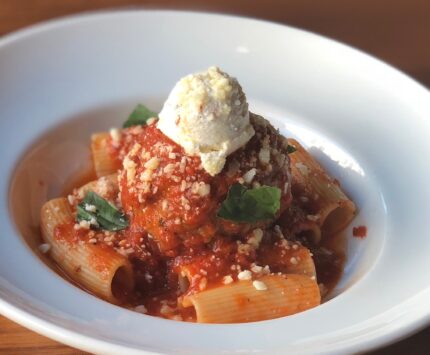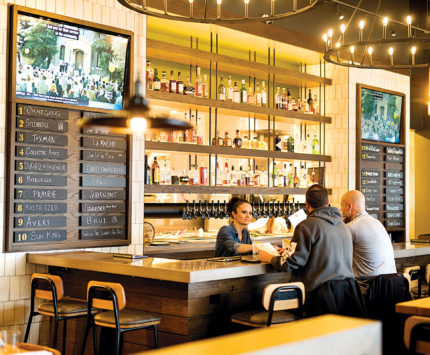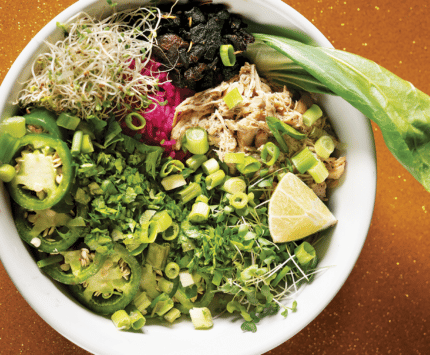A Conversation With Abel Garcia Of Cardinal Spirits

Cardinal Spirits’ Abel Garcia.Photo by Anna Powell Denton
Pivoting to carryout wasn’t exactly the plan for executive chef Abel Garcia when he took the helm at Cardinal Spirits in Bloomington last February. But making sure that the carryout survived the drive home, as well as sourcing as many ingredients from local producers and from the leftovers of the spirits-making process as possible, was a challenge this Chicago native who grew up in Columbus, Indiana, was definitely up to. Here, the chef and podcast co-host who is usually asking the questions takes some time to muse on his roots as a chef, where we’re at in culinary history, and where we’re going in the post-pandemic future.
After working at Finch’s Brasserie and The Roost in Bloomington, you came on at Cardinal Spirits just weeks before restaurants closed for the pandemic. What did you have planned for your new position?
When I came on at Cardinal Spirits, they had a sous chef and three other people, a nice solid team that knew each other well. But they needed a confident leader to make decisions, and I wanted to bring on my own concept and my own vision of slow food to the menu. The pandemic actually made that somewhat easier, as we began to recognize some cracks in the global food system. When that began to break down at the supply level, we just turned to local farmers, which is what I wanted to do all along. We also had the advantage of being able to put some of our culinary staff to work on the bottling line or in production of hand sanitizer that we ramped up. For the first couple of months, I was mostly planning the staff meals and keeping people alive. We had some staff with family or some older staff who were more at risk. I was happy that we could actually let our employees decide what they wanted to do.
What kinds of things did you do once you started your menu up again?
While we were off, I would sometimes order carryout from places I really liked, and then I would get home and notice that the bun was soggy. And why did I get fries? They were cold and limp. I wondered why no one was rethinking carryout for the long run. I didn’t just want to put it in a box and call it a day. I wanted to make my carryout menu with items that would be just as good after a 10- to 15-minute drive home on the floorboard or in the trunk. I even had some customers and staff who would test it out for me. Putting sauces and dressings on the side and making more things that were great at room temperature were definitely key. But I also played with the recipes for things like ice cream. My friend would call and say the ice cream was good, but it was a little soft or runny, so I adjusted the amount of alcohol and other ingredients so it wouldn’t melt as quickly.
What was behind your decision not to offer patio service in warm weather?
We were concerned with the health of our staff, first and foremost. And if you look at our place, it’s so narrow and small that with all of the stuff we had to bring in for carryout, there just wasn’t enough space. The expectation that a restaurant run both a full-service carryout menu and in-person dining is just not realistic. If you think about it, most people want their carryout meals from 6 to 7 in the evening. The intensity of that makes it impossible to give good service for the customers who dine in. We just never even considered it.
You also made a commitment to using more byproducts of the distilling process. What things did you end up recovering?
When I got here, I looked around and saw that when we made certain spirits that there was a lot of waste. Some of those ingredients were quite expensive. I wondered why no one had put A and B together. For instance, for our Lake House spiced rum and some of the other spirits, I could reuse vanilla beans, peppercorns, cinnamon sticks, and organic orange peels. And we weren’t using as many of our spirits that we already had around, so I started doing more of that, like in my amaro cake, which uses our La Boite Amaro. We also do a lot of things here to tap local businesses to help such as having The Chocolate Moose churn our ice cream. Saving a buck wherever we can really helps us do more, and it lowers our carbon footprint at the same time.
Where did your love of cooking come from?
I was born in Chicago and grew up in a big Mexican family. I moved to Columbus when I was in 6th grade. It’s a really traditional Catholic family where the gender roles were pretty strict, so I wasn’t allowed to help the women in my family cook for big meals and holidays. Probably in my early 20s, I started working at Papa John’s, and then I started setting up bars for bartenders. I started cooking for friends at home, big grill-outs and tailgating. But I was around a lot of kitchens, and I had an advantage from being who I was. The chefs would say, “Wait, you’re Mexican, but you speak English?” I have a bad memory, so I be would the guy in the kitchen writing everything down in a notebook. That’s how I gained so much of my culinary knowledge. And now my family is more than happy for me to cook for them.
You also host special episodes of the No Dishes Podcast called “Shift Change.” What’s the concept of that?
The name comes from that point in the day at a restaurant when the staff changes and they pass on the information from one cook to the next, what you need to know to do your work. I try to catch food industry guests at that moment and get their insights or whatever they’re thinking when they’re getting out of their work mode. I learn a lot from chatting with local food people about their experience, the legendary local restaurants they’ve cooked at, and what they do when they’re not working.
What do you look forward to the most about going back to in-person dining?
I miss getting to use my artistic eye for plating. Like one time I had been watching my friend’s kid playing a video game, and I saw a waterfall, and I wanted to make that happen on a plate. So I did it with a short rib special where the rib was a log, microgreens were the waterfall, and the water was a pool of mole. Sometimes when I do big cheese and meat boards, I try to make them look like a painting. I made one that was the entire bay of Acapulco with mountains, water, and even Sylvester Stallone’s house. I can’t wait to get back to doing crazy things like that.





